If wind energy is ‘strong,’ why does it need subsidies?
Loading...
Back in January, tax credits for wind energy were set to expire. But a vote by the US Senate Finance Committee in mid-July overwhelmingly re-upped tax incentives and policies that support wind farms.
Supporters of the wind Production Tax Credit (PTC) are applauding lawmakers for the bipartisan vote, and wind energy is amassing support from a broad base. Advocates call it a necessary substitute to fossil fuels in the fight against climate change.
The private sector is making the business case for wind, with Amazon, Facebook, and Hewlett-Packard announcing in the second quarter plans to invest in vast wind farms in North Carolina for Amazon, and Texas for Facebook and HP, in order to power massive data centers for the tech companies, which will provide, after the initial investment, free, renewable energy while adding utility power to the grid. For investors in wind, the cash subsidies provided by the federal government to non-renewables like oil, gas, and coal have long been a sticking point, with renewable energy providers wanting a more even access to capital in order to gain a foothold in the electricity market.
Critics of subsidized wind energy cite the unreliability of wind power when compared to the 24/7 capacity of power plants. When the Republican-majority Senate struck down an $85 billion tax package in 2014 that included a subsidy for wind, politicians said at the time they did not want to prop up an industry that unfairly favored certain states, citing a study done by the Institute for Energy Research that estimated state-level impact of subsidies.
The Republican-majority Senate Finance Committee this time approved, on a final vote of 23-3, a “tax extenders” bill preserving language that allows wind farms to qualify for the tax incentives. The credits that expired at the start of this year cast temporary doubt on the future of American wind energy, which has weathered uncertainty each time the PTC comes up for a vote to be expanded or renewed, which has occurred numerous times since it was originally enacted in 1992.
The PTC expiration date in January had brought to an end a $23 tax credit for every megawatt-hour of electricity a wind turbine generates, whether the turbine is privately owned or part of a public utility. A megawatt-hour is enough to power about 1,000 homes for one hour, according to Bloomberg. The credit, which was worth about $2 billion for all US wind projects in 2013, has brought down the price of electricity in areas of the country where wind power flourishes, since wind farms can charge less and still turn a profit.
According to Bloomberg, “In Texas, the biggest wind-producing state in the US, wind farms have occasionally sold electricity for less than zero – that is, they’ve paid to provide power to the grid to undercut the state’s nuclear or coal energy providers.”
The vote to renew PTC again “is a big step in the right direction,” said Tom Kiernan, CEO of the American Wind Energy Association (AWEA). “We urge the full Senate and the House of Representatives to follow the Senate Finance Committee’s bipartisan lead, and quickly pass this tax extenders package."
According to AWEA, in 2013, after the renewable energy tax credits were allowed to expire even briefly, installations of new wind farms fell 92 percent, causing a loss of 30,000 jobs across the industry that year. After Congress renewed the PTC, the US wind energy industry added 23,000 jobs the following year, bringing the total to 73,000 at the end of 2014, AWEA adds.
Wind Vision, a Department of Energy report released in early 2015, projected that with stable policy, wind will continue to grow, with potential to supply 10 percent of the nation’s electricity demand by 2020, 20 percent by 2030, and 35 percent by 2050.






